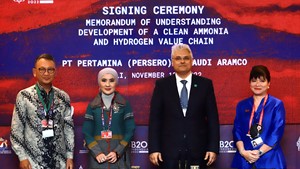News
Aramco and Pertamina explore H2 and ammonia value chain at B20
Aramco and Indonesia’s PT Pertamina (Persero) are exploring collaboration across the H2 and ammonia value chain. The companies signed a MoU outlining future cooperation across this key pathway of the energy transition, in a ceremony that took place alongside the B20 Summit in Bali, the official G20 dialogue forum with the global business community.
G20 members and global energy companies have jointly committed to be part of the solution to the global energy crisis which is affecting millions of people worldwide – and which forms the backdrop to the G20 Summit in Bali.
The MoU was signed by the President Director of Persero, Nicke Widyawati, and Mohammed Y. Al Qahtani, Aramco Senior Vice President of Downstream. Clean ammonia and H2 development have significant roles in Indonesia's 2060 net zero emissions roadmap and the country is expected to be a key player in green H2 production in Asia.
Aramco Senior Vice President of Downstream, Mohammed Y. Al Qahtani said, “As a company, our ambition is to achieve net-zero scope 1 and 2 greenhouse gas emissions across our wholly-owned operated assets by 2050. Our work in developing new ammonia and H2 energy pathways will be pivotal in achieving that goal while helping to advance an affordable, equitable and more sustainable transition for all.”
President Director of Pertamina, Nicke Widyawati said, “The energy transition should not jeopardize energy security and affordability, especially for countries that are still dependent on fossil fuels. That's why Pertamina has developed a decarbonization program through CCUS. H2 and Ammonia are expected to play a key role in a future climate-neutral economy, enabling emission-free power generation, heavy transport, heating and industrial processes.”
The MoU involves a pre-feasibility study that aims to assess the possibility of cooperation related to the development of a clean ammonia and H2 value chain. It includes potential CCUS at Pertamina Group's existing facilities and other agreed potential locations. The study will explore investment viability and jointly develop commercialization options, including but not limited to business organization and commercial structures for clean ammonia and H2 in Indonesia. The study is expected to be conducted over the next two years and depending on outcomes may be developed further.


